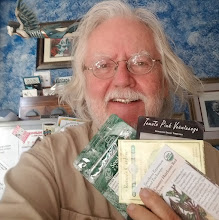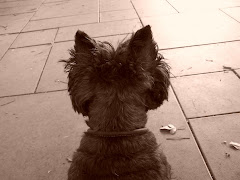I was approached by a young woman wanting to learn how to teach others how to garden even though she feels she needs to learn more about it herself. Probably no other goal lends itself more to my passion and what I most love to teach. I have often dreamed I would run away from home and join the Peace Corps and go off to grow food in other parts of the world. I have fantasized about being sent to the country of Georgia (home to garlic), or other places where I could learn about the land races of different foods.
Back in the late 1980's I read Save Three Lives by Robert Rodale and Mike McGrath; Rodale was killed before the book was finished. This book galvanized my thinking and long before it was common knowledge that there was no food shortage in the world that couldn't be fixed with political will and transportation, I understood that our government - along with the other imperial powers - perpetuated famine a lot more than they actually relieved it. Since then, The White Man's Burden
by Robert Rodale and Mike McGrath; Rodale was killed before the book was finished. This book galvanized my thinking and long before it was common knowledge that there was no food shortage in the world that couldn't be fixed with political will and transportation, I understood that our government - along with the other imperial powers - perpetuated famine a lot more than they actually relieved it. Since then, The White Man's Burden showed how that problem, in the years since Rodale's book had only gotten worse, not better.
showed how that problem, in the years since Rodale's book had only gotten worse, not better.
When I went to Guatemala, I took copies Rodale and McGraths' book to give away while I was there - and I have frequently given this book to those I think could use it and grasp its importance. I still refer back to it and it occupies a place of honor on my bookshelf.
I also took Out Of The Earth with me to Guatemala, though it is not a 'how-to' agriculture book. Daniel Hillel has written a truly readable book about mankind's relationship with the soil that approaches poetry in many paragraphs. I have read passages from this book to classes I teach on soils - I have had students from those classes tell me five years on that the one thing they loved the most about my soils class was that I turned them on this book.
with me to Guatemala, though it is not a 'how-to' agriculture book. Daniel Hillel has written a truly readable book about mankind's relationship with the soil that approaches poetry in many paragraphs. I have read passages from this book to classes I teach on soils - I have had students from those classes tell me five years on that the one thing they loved the most about my soils class was that I turned them on this book.
But the book I read that first intimated that there are other ways to grow things was J. Russell Smith's Tree Crops. The current reprint is from 1987, but the original manuscript was first published in the first third of the 1900's, reprinted again sometime in the 1950's! This man should have won a bunch of prizes, because, like Small is Beautiful , Schumacher's brilliant essay written far in advance of everything else along that line, Smith at that early date decries the destruction of the rain forest (what would he say today?) and postulates the beginnings of permaculture. And judging by the price on this book at Amazon, I'm going into my office right now and taking my copy home! With this book and Rodale's book provide a solid study on a new way to feed people - especially in lands with erratic rainfall. A term that could be used to describe much more of the Earth now that climate change is so obviously an everyday part of life on this planet.
, Schumacher's brilliant essay written far in advance of everything else along that line, Smith at that early date decries the destruction of the rain forest (what would he say today?) and postulates the beginnings of permaculture. And judging by the price on this book at Amazon, I'm going into my office right now and taking my copy home! With this book and Rodale's book provide a solid study on a new way to feed people - especially in lands with erratic rainfall. A term that could be used to describe much more of the Earth now that climate change is so obviously an everyday part of life on this planet.
All these books set the stage for one to appreciate some new ways of frying the same old fish, but for a 'how-to,' one can't go much righter than John Jeavon's How To Grow More Vegetables and Fruits Than You Ever Thought Possible on Less Land Than You Can Imagine. I do NOT subscribe to Jeavon's double digging, but the crops he plants, the spacings he uses and all the data he has on how many row feet to feed this number of folks a good diet and all the data on compost makes this a reference that is unbeatable on today's market.
Instead of all that double digging, I suggest the regimen first postulated by Fukuoka, in One Straw Revolution , especially when coupled with the work of Emily Hazelip as seen on You Tube videos. She took the Fukuoka method and 'translated' it to a French market garden. Although I have yet to put her methodology into total practice, I try emulate as much as I can and I have a goal to work towards.
, especially when coupled with the work of Emily Hazelip as seen on You Tube videos. She took the Fukuoka method and 'translated' it to a French market garden. Although I have yet to put her methodology into total practice, I try emulate as much as I can and I have a goal to work towards.
Remember, the idea that we need machines, hybrids, fertilizers and insecticides to produce food for the masses is mostly a set of lies designed to sell us products we don't really need. Mind you, I can see where a small tractor and some mechanical assistance would be helpful, but it's not essential. In fact, the most productive way to grow food is not on a farm at all, but in a garden where most of the work is done by hand: calorie for calorie the garden is the most efficient way to produce food. In fact, the bigger the operation, the less efficient the process. The so-called 'economy of scale' does not work for growing food unless one feels no compunction about poisoning the earth, the water or the workers and doesn't mind food grown in stressful conditions.
And food of lesser quality as far as nutrients and taste are concerned. Another bill of goods we have been sold is the idea of the unblemished, perfect fruit. Those fruits that have no marks, no bites from them are only possible as long as heavy doses of poisons are used to kill insects. It is a price Americans need to learn is too high. In fact, the blemished fruit needs to be held up as the epitome of goodness, Mom apple pie and all that is right in the world.
But that's a fight that will have to come later - right now, lets learn as much as we can about how one grows a complete diet at home for one family and understand the urgency and importance of that.
david






.jpg)